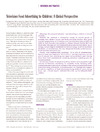Identificador persistente para citar o vincular este elemento:
https://accedacris.ulpgc.es/jspui/handle/10553/44726
| Título: | Television food advertising to children: A global perspective | Autores/as: | Kelly, Bridget Halford, Jason C.G. Boyland, Emma J. Chapman, Kathy Bautista-Castaño, Inmaculada Berg, Christina Caroli, Margherita Cook, Brian Coutinho, Janine G. Effertz, Tobias Grammatikaki, Evangelia Keller, Kathleen Leung, Raymond Manios, Yannis Pedley, Claire Prell, Hillevi Raine, Kim Recine, Elisabetta Serra-Majem, Lluis Singh, Sonia Summerbell, Carolyn |
Clasificación UNESCO: | 32 Ciencias médicas 3206 Ciencias de la nutrición |
Palabras clave: | Australia Food advertising Child |
Fecha de publicación: | 2010 | Editor/a: | 0090-0036 | Publicación seriada: | American Journal of Public Health | Resumen: | Objectives. We compared television food advertising to children in several countries. Methods. We undertook a collaboration among 13 research groups in Australia, Asia, Western Europe, and North and South America. Each group recorded programming for 2 weekdays and 2 weekend days between 6:00 and 22:00, for the 3 channels most watched by children, between October 2007 and March 2008. We classified food advertisements as core (nutrient dense, low in energy), noncore (high in undesirable nutrients or energy, as defined by dietary standards), or miscellaneous. We also categorized thematic content (promotional characters and premiums). Results. Food advertisements composed 11% to 29% of advertisements. Noncore foods were featured in 53% to 87% of food advertisements, and the rate of noncore food advertising was higher during children's peak viewing times. Most food advertisements containing persuasive marketing were for noncore products. Conclusions. Across all sampled countries, children were exposed to high volumes of television advertising for unhealthy foods, featuring child-oriented persuasive techniques. Because of the proven connections between food advertising, preferences, and consumption, our findings lend support to calls for regulation of food advertising during children's peak viewing times. | URI: | https://accedacris.ulpgc.es/handle/10553/44726 | ISSN: | 0090-0036 | DOI: | 10.2105/AJPH.2009.179267 | Fuente: | American Journal Of Public Health [ISSN 0090-0036], v. 100 (9), p. 1730-1736 |
| Colección: | Artículos |
Citas SCOPUSTM
332
actualizado el 08-jun-2025
Citas de WEB OF SCIENCETM
Citations
297
actualizado el 08-jun-2025
Visitas
135
actualizado el 27-sep-2025
Descargas
572
actualizado el 27-sep-2025
Google ScholarTM
Verifica
Altmetric
Comparte
Exporta metadatos
Los elementos en ULPGC accedaCRIS están protegidos por derechos de autor con todos los derechos reservados, a menos que se indique lo contrario.
